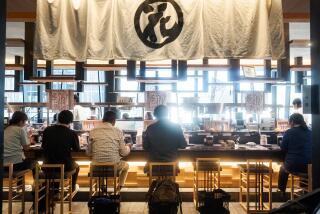Refined Survey of Okinawa’s Traditional Performing Arts
- Share via
Companies specializing in the traditional performing arts of Okinawa now visit Los Angeles so frequently that such Ryukyu splendors as the huge red-and-blue flower hats of the “Kuwadesa” dance are as familiar locally as Kabuki wisteria-maidens or West African dancing haystacks.
A new survey of Okinawan culture deftly showcased court, folk, martial arts and contemporary creative idioms Saturday at the Japan America Theatre, with an emphasis on the stately refinement characteristic of the Tamagusuku School. A different, smaller group represented that school in the same theater four years ago and, as on Saturday, female grace dominated the program.
Other Okinawan troupes, however, contrast the delicate, restrained women’s dances with displays of male vigor and bravura. Here, even the raucous folk dances and the warrior showpieces were mostly assigned to women, then artfully feminized--so when males did finally cut loose in a raucous lion-dance and an athletic quartet with wooden oars, their approach seemed more of an anomaly than an alternative.
Indeed, the distinguished company leader, Yukimasa Hirata, lent his authority to a woman’s role in the comic “Ashibimoui,” while his son, Tomoyuki Hirata, exemplified classic elegance and emotional subtlety in “Hanafu.”
The company boasted a well-drilled children’s corps but gloried in its rich musicianship: mostly guitar-like shan-shin and zither-like koto at the start of Act 1 and mostly drums in the opening of Act 2. The involvement of master instrumentalists Masao Shimabukuro and Tsunetoshi Higa confirmed the importance of the occasion.
More to Read
The biggest entertainment stories
Get our big stories about Hollywood, film, television, music, arts, culture and more right in your inbox as soon as they publish.
You may occasionally receive promotional content from the Los Angeles Times.










